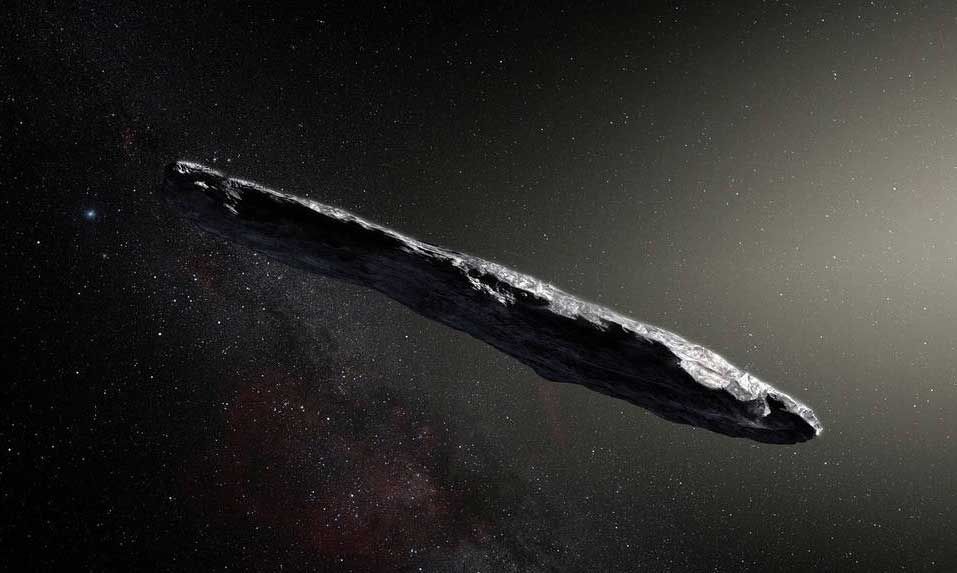[ad_1]

An artist’s concept of interstellar object ‘Oumuamua as it passed through the solar system after its discovery in October 2017. European Southern Observatory/M. Kornmesser
In 2017, the Pan-STARRS astronomical observatory in Hawaii detected a strange object in the sky that was flying in an unusual trajectory at a speed four times faster than a typical asteroid. They named it ‘Oumuamua (pronounced “oh-mooah-mooahâ€), roughly meaning “scout†in Hawaiian.
‘Oumuamua was unlike anything astronomers had seen before. Its trajectory and speed suggested that it came from another star system. But its lack of a detectable gas tail ruled out the possibility of it being a comet, leading some scientists, notably Harvard’s top astronomer Avi Loeb, to wonder if it could be some sort of an artifact of an alien technology.
A new study by two Arizona State University astrophysicists has rejected that hypothesis. In a pair of papers published in the AGU Journal of Geophysical Research: Planets, Steven Desch and Alan Jackson of the ASU’s School of Earth and Space Exploration have determined that ‘Oumuamua is most likely a piece of a “Pluto-like†planet from another star system.
See Also: Why Aliens Likely Exist and Visited Us in 2017, According to Harvard’s Top Astronomer
“We’ve probably resolved the mystery of what ‘Oumuamua is, and we can reasonably identify it as a chunk of an ‘exo-Pluto,’ a Pluto-like planet in another solar system,â€Â Desch, the study’s co-author and an astrophysicist at ASU, said in a press release Monday.
“In many ways ‘Oumuamua resembled a comet, but it was peculiar enough in several ways that mystery surrounded its nature, and speculation ran rampant about what it was,†he explained. In other words, ‘Oumuamua is very much like a comet, but unlike any that we’ve seen before.
Among the many studies around ‘Oumuamua since 2017, there was one prevailing hypothesis suggesting that it’s a hydrogen iceberg, in which case we would not see a gas tail even if it evaporates like a comet, because hydrogen is transparent. Yet, Loeb’s study shows that a hydrogen iceberg from interstellar space would have long evaporated before it reached our solar system.
Taking that idea further, Desch and Jackson studied whether ‘Oumuamua could be made of other types of ice. Eventually they found one kind of ice—solid nitrogen—that exactly matched all of ‘Oumuamua characteristics. And since solid nitrogen ice can be seen on the surface of Pluto, it is possible that a comet-like object could be made of the same material.
“We knew we had hit on the right idea when we completed the calculation for what albedo (how reflective the body is) would make the motion of ‘Oumuamua’ match the observations,†said Jackson, a planetary scientist at ASU. “That value came out as being the same as we observe on the surface of Pluto or Triton, bodies covered in nitrogen ice. It was likely knocked off the surface by an impact about half a billion years ago and thrown out of its parent system.â€
Being made of frozen nitrogen also explains the unusual pancake-like shape of ‘Oumuamua, which scientists deduced based on how it reflected sunlight. “As the outer layers of nitrogen ice evaporated, the shape of the body would have become progressively more flattened, just like a bar of soap does as the outer layers get rubbed off through use,†Jackson explained.
‘Oumuamua was already flying away from us when it was first detected, so there’s limited observation data scientists could work with. Desch and Jackson hope that future telescopes, such as the Vera C. Rubin Observatory/Large Synoptic Survey Telescope in Chile, will be able to survey the sky for interstellar objects on a regular basis.
“It takes tens of thousands of years for an object like ‘Oumuamua to traverse the entire solar system, so at any given time there are a huge number of such objects—quadrillions of such objects—in the solar system,†Loeb told Observer in January. “According to our calculation, it should detect at least one object like ‘Oumuamua every month.â€
[ad_2]
Source link






